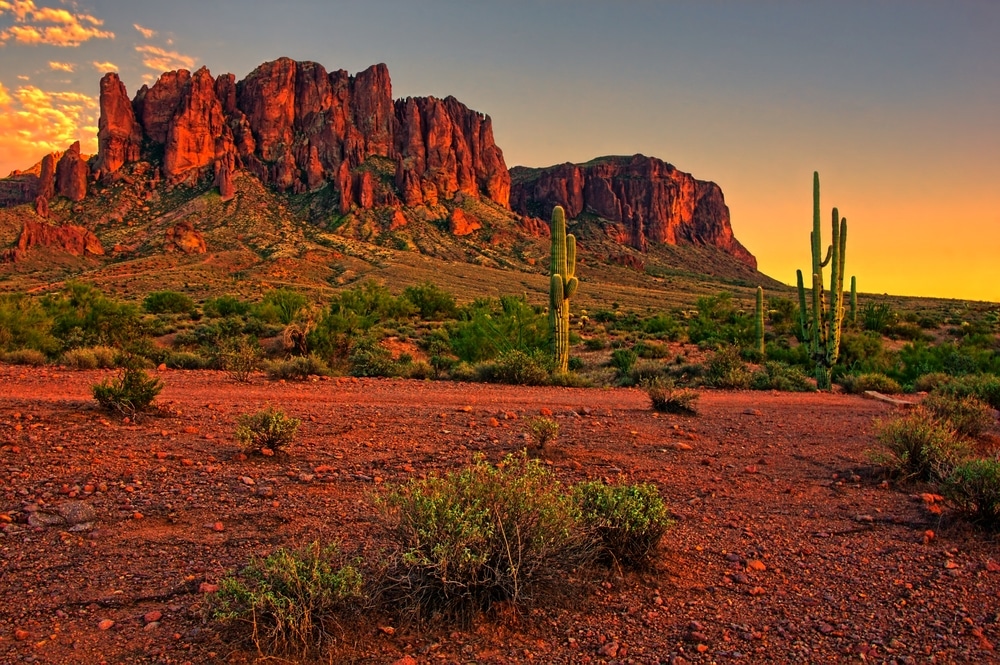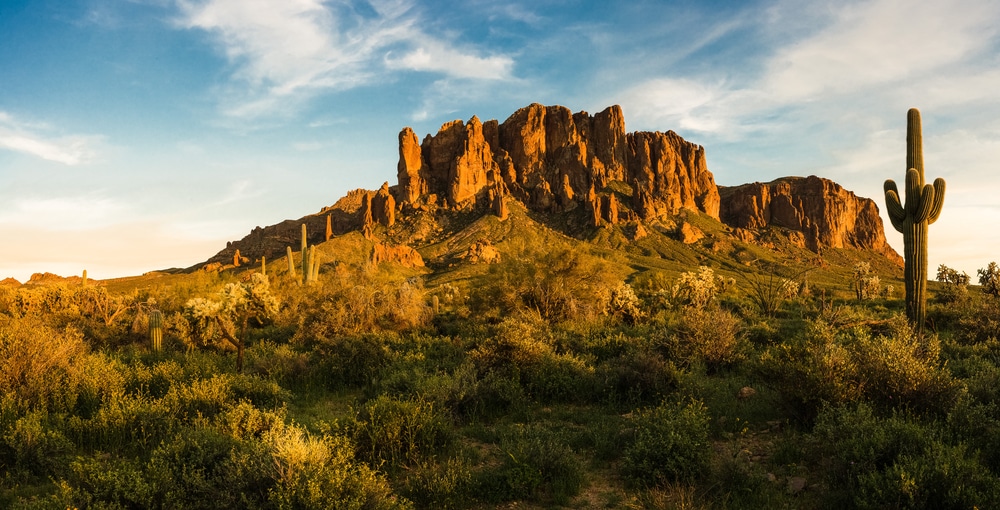Nestled at the base of the majestic Superstition Mountains just 40 miles east of Phoenix, Lost Dutchman State Park stands as one of Arizona’s most captivating natural treasures. Named after the legendary lost gold mine that has enticed prospectors for generations, this 320-acre park serves as a gateway to adventure in the rugged Sonoran Desert landscape.
The park’s story begins in 1972 when the Bureau of Land Management (BLM) developed it as a day-use recreation area. In 1977, after legislation amended the Federal Recreation and Public Purposes Act to allow states to acquire federal land for recreational purposes at no cost, the land was transferred to the state of Arizona, officially establishing Lost Dutchman State Park. An additional 28 acres were acquired through a lease in 1983, expanding the park to its current size.

The park’s namesake comes from the fabled tale of Jacob Waltz, a German immigrant (often mistakenly called “Dutch” rather than “Deutsch”) who allegedly discovered a rich gold mine in the Superstition Mountains in the 1870s. As the story goes, Waltz emerged from the mountains with a satchel full of gold but never revealed the mine’s location before his death in 1891. This mystery has sparked countless expeditions, with some searchers meeting unfortunate ends, further fueling the mountains’ mysterious reputation.
Today, visitors come not in search of gold, but to experience the spectacular hiking and biking trails, witness breathtaking desert vistas, and enjoy tranquil camping under vast starry skies. The park offers a perfect blend of accessible wilderness adventure and comfortable amenities, making it an ideal destination for both day-trippers and overnight guests looking to immerse themselves in the beauty of the Sonoran Desert.

Multiple day-use areas throughout the park offer picnic tables, grills, and shade ramadas with spectacular mountain views. These facilities are strategically placed to take advantage of scenic vistas while providing comfort in the desert environment. Group picnic areas with larger capacity are available by reservation for family gatherings and special events.

The visitor center features exhibits detailing the fascinating legend of the Lost Dutchman’s Gold Mine that gives the park its name. Interactive displays explain how German immigrant Jacob Waltz allegedly discovered a rich gold deposit in the Superstition Mountains and took its location to his grave, spawning a treasure hunting tradition that continues today. Rangers provide contextual information separating historical facts from the colorful folklore that has developed around this enduring mystery.

Lost Dutchman State Park offers an extensive network of trails ranging from easy nature walks to challenging mountain climbs. The Treasure Loop Trail provides a moderate 2.4-mile route with spectacular views of the Superstition Mountains, while the more strenuous Siphon Draw Trail leads ambitious hikers toward the iconic Flatiron formation. Native Plant Trail offers an accessible interpretive experience highlighting Sonoran Desert vegetation. These diverse paths showcase the rugged beauty that has captivated visitors and treasure hunters for generations.

The dramatic silhouette of the Superstition Mountains against colorful Arizona skies creates exceptional photography opportunities. Sunrise and sunset are particularly magical as changing light transforms the rugged peaks and distinctive rock formations. Spring wildflower blooms add vibrant foreground elements to landscape compositions, while unique geological features and diverse desert wildlife provide compelling subjects throughout the year.

The diverse habitats within the park support numerous bird species, from tiny hummingbirds to impressive birds of prey. Cactus wrens, Gambel’s quail, and gilded flickers are commonly spotted year-round residents, while various migratory species visit seasonally. The transition zone between lower desert and higher elevations creates ecological niches for different bird communities, rewarding patient observers with diverse sightings.

The park maintains 138 developed campsites accommodating tents and RVs with both electric/water hookups and more primitive options available. Each site includes a picnic table, fire ring, and grill, with modern restrooms and hot showers nearby. The campground’s location at the base of the Superstition Mountains provides dramatic backdrops and spectacular sunrise views from every site. During winter and spring, reservations are strongly recommended due to high demand.
Located away from major urban light pollution, Lost Dutchman offers excellent conditions for astronomical observation. The dark skies and clear desert air create ideal conditions for viewing stars, planets, and celestial events. The park occasionally hosts star parties with telescopes and guided constellation tours, taking advantage of Arizona’s renowned dark sky viewing conditions.

| Detail | Information |
|---|---|
| Location | Apache Junction, Arizona (near the Superstition Mountains) |
| Established | 1977 |
| Size | 320 acres |
| Named After | The legendary Lost Dutchman’s Gold Mine |
| Elevation | Approximately 2,000 feet |
| Terrain | Sonoran Desert landscape with dramatic mountain views |
| Main Attraction | Superstition Mountains and associated folklore |
| Hiking Trails | Multiple trails of varying difficulty including Treasure Loop, Jacob’s Crosscut, Prospector’s View |
| Wildlife | Desert bighorn sheep, mule deer, javelina, coyotes, various reptiles and birds |
| Flora | Saguaro cacti, ocotillo, cholla, barrel cactus, palo verde trees |
| Camping | 138 campsites (both developed and semi-developed) |
| Activities | Hiking, camping, picnicking, photography, stargazing, wildlife viewing |
| Best Time to Visit | October through April (cooler weather) |
| Visitor Center | Features exhibits on area history, flora and fauna |
| Annual Events | Moonlight hikes, stargazing programs, Native American festivals |
| Nearby | Goldfield Ghost Town, Apache Trail, Canyon Lake |
Lost Dutchman State Park lies within the stunning Sonoran Desert at an elevation of approximately 2,000 feet. The park serves as the western gateway to the imposing Superstition Mountain range, which dominates the landscape with its dramatic rock formations and rugged peaks. These mountains stand as silent sentinels, changing colors throughout the day as the sun makes its journey across the sky—from golden hues at dawn to fiery oranges and reds at sunset.
The Superstition Mountains themselves are the product of intensive volcanic activity that occurred approximately 25 million years ago during the mid-tertiary period. Volcanoes in this region emitted an estimated 2,500 cubic miles of ash and lava, with ash spreading as far as present-day Florence and Roosevelt Lake. The subsequent collapse of these volcanoes into their partly emptied magma chambers created depressions or calderas. The mountains visible today were formed through an upthrust of thick lava within the largest of these calderas, followed by millions of years of erosion that sculpted the distinctive formations we see today.
The geological composition of the mountains includes welded tuff (volcanic ash cemented under extreme heat), breccia (rock fragments cemented together with lava or welded tuff), granite, dacite, basalt, and some conglomerate. Small gold deposits can be found in the surrounding areas, which likely contributed to the legends of lost mines. Interestingly, hikers sometimes report hearing rumblings similar to rolling thunder while in the mountains—a phenomenon geologists attribute to seismic activity resonated by the canyon walls, though local Apache legend holds that these mountains are home to thunder gods.
The park’s terrain varies from relatively flat desert floor to steep mountain slopes. Numerous washes and arroyos cut through the landscape, evidence of seasonal water flows that have shaped the land over centuries. While there is no permanent lake or river within the park boundaries, seasonal rains create temporary water features that attract wildlife and support the desert ecosystem.
In spring, particularly after wet winters, the desert floor transforms with a spectacular display of wildflowers. Golden poppies, purple lupines, orange globe mallows, and countless other species create a colorful carpet that contrasts beautifully with the green saguaros and the rugged mountain backdrop. This seasonal transformation demonstrates the resilience and adaptability of desert plant life in response to the rare gift of abundant water.
Lost Dutchman State Park showcases the remarkable biodiversity of the Sonoran Desert ecosystem. This desert is unique among North American deserts for its relatively lush vegetation, supported by bi-seasonal rainfall patterns that provide moisture during both winter and summer months.
The park’s landscape is characterized by iconic saguaro cacti (Carnegiea gigantea), which can grow up to 40 feet tall and live for 150-200 years. These majestic plants serve as living symbols of the American Southwest and provide essential habitat for numerous desert species. Other common cacti include the barrel cactus, cholla, and prickly pear, each adapted with specialized features to conserve water and survive harsh desert conditions.
Desert trees and shrubs found throughout the park include:
Throughout the year, but especially after seasonal rains, visitors may encounter a variety of desert wildflowers. Depending on winter rainfall amounts, spring can bring spectacular wildflower displays, with Mexican gold poppies, lupines, brittlebush, and desert marigolds transforming the park into a colorful canvas. The Native Plant Trail within the park provides an excellent opportunity to observe and learn about these desert adaptations up close.
Wildlife abounds within the park’s boundaries, though many species are most active during dawn, dusk, or nighttime hours to avoid the intense daytime heat. Mammals frequently spotted include:
Smaller mammals like ground squirrels, pocket mice, and kangaroo rats are also present but more difficult to observe.
The park has become increasingly popular for birdwatching, with numerous resident and migratory species present throughout the year. Winter brings an influx of species from northern states, making it an especially rewarding time for birders. Common birds include Gambel’s quail, cactus wrens, curve-billed thrashers, gila woodpeckers, and various hawks and falcons. Lucky visitors might spot a roadrunner darting across a trail or glimpse a great horned owl nestled in a saguaro cavity.
Reptiles are well-represented in the park’s ecosystem, with various lizards such as the western whiptail and desert spiny lizard being commonly seen during warmer months. Several snake species inhabit the park, including the western diamondback rattlesnake, so visitors should remain alert and stay on designated trails. The desert tortoise, though rarely encountered, is also native to the area and protected by law.
The interconnected relationships between the park’s plants and animals create a delicate but resilient ecosystem that has evolved over millennia to thrive in this seemingly harsh environment. Seasonal changes bring different species to prominence, making repeated visits throughout the year a rewarding experience for nature enthusiasts.
Lost Dutchman State Park offers a diverse range of recreational opportunities that allow visitors to immerse themselves in the beauty of the Sonoran Desert while enjoying activities suited to various interests and ability levels.
Hiking is undoubtedly the park’s most popular activity, with several well-maintained trails providing access to stunning desert landscapes and breathtaking mountain views. The trail system caters to all skill levels, from casual walkers to experienced hikers seeking a challenge:
For the most adventurous hikers, Siphon Draw Trail connects with the unmaintained but popular route to Flatiron, the most iconic advanced hike in the Superstitions. This strenuous 5.8-mile round trip involves significant scrambling and route-finding skills but rewards hikers with unparalleled views from the summit. Due to the difficulty, it’s recommended only for experienced hikers in good physical condition, and at least five hours should be allowed for completion.
Mountain biking enthusiasts can enjoy the park’s 4-mile singletrack loop that traverses the foothills. Rated beginner to intermediate, this trail offers fast and flowing sections mixed with technical challenges as it crosses rocky terrain and sandy washes. Bikes can also use the multi-use trails in the adjacent Tonto National Forest, though they are not permitted beyond the Wilderness Boundary on Siphon Draw Trail.
Photography opportunities abound throughout the park, with the changing light throughout the day creating different moods and highlighting various aspects of the landscape. Sunrise and sunset are particularly magical times, as the mountains glow with golden light and long shadows accentuate the texture of the desert. Spring wildflower seasons and monsoon storms provide additional dramatic photography opportunities.
While fishing is not available within the park itself as there are no permanent water bodies, nearby Canyon Lake (about 15 miles northeast along the Apache Trail) offers excellent fishing for bass, crappie, bluegill, and rainbow trout in a scenic setting.
Stargazing has become increasingly popular at Lost Dutchman, thanks to the relatively dark skies compared to nearby urban areas. The park occasionally hosts star parties with local astronomers who bring telescopes and share their knowledge of the night sky. The clear desert air and minimal light pollution (particularly to the east) create ideal conditions for observing stars, planets, and celestial events.
Wildlife watching rewards patient visitors, particularly during early morning and evening hours when animals are most active. The park’s varied habitats support diverse wildlife, and quiet observation from trails or campsite areas often yields sightings of desert creatures going about their daily routines.
During all activities, visitors should remember that desert conditions can be extreme. Carrying plenty of water (at least one gallon per person per day during warmer months), wearing appropriate sun protection, and being aware of weather conditions are essential safety practices. Summer temperatures regularly exceed 100°F, making early morning activities advisable during hot months.
Lost Dutchman State Park provides excellent camping facilities that allow visitors to fully immerse themselves in the desert environment while enjoying modern conveniences. The campground’s stunning setting against the backdrop of the Superstition Mountains creates a camping experience that combines natural beauty with comfort.
The park features 135 campsites spread across several camping areas, accommodating both tent campers and RV enthusiasts:
Each regular campsite comes equipped with a picnic table, fire pit with adjustable grill gate, and parking space. The campground is designed with paved roads throughout, and there are no size restrictions on RVs, making it accessible for larger recreational vehicles and trailers. While not all sites offer the same views or privacy levels, many sites provide spectacular vistas of the Superstition Mountains, particularly beautiful at sunrise and sunset.
The park’s five solar cabins represent a relatively new accommodation option, offering climate-controlled comfort for those who prefer not to camp in tents or RVs. Each cabin can sleep up to six people and features two covered porches that provide perfect vantage points for enjoying the desert scenery throughout the day. The cabins are located steps away from a washhouse facility with restrooms and showers.
Campground amenities include clean restrooms with flush toilets, hot water, and shower facilities. A dump station is available for RV campers to dispose of waste before departing. These facilities are reserved exclusively for overnight guests; day-use visitors do not have access to the showers or dump station.
For visitors seeking a more rustic experience, the three hike-in or bike-in sites offer increased solitude and a closer connection to nature. These sites require carrying camping gear a short distance but reward campers with a more secluded setting.
Campsite reservations can be made online through the Arizona State Parks website or by calling the reservation desk at 1-877-MY-PARKS (1-877-697-2757) between 8 a.m. and 5 p.m. A non-refundable reservation fee of $3.60 applies per campsite. During busy seasons, particularly spring weekends and holidays, reservations are strongly recommended as the campground frequently fills to capacity.
Check-in procedures are straightforward—during business hours, campers can check in at the park office, while after-hours arrivals with reservations can proceed directly to their assigned site after collecting a map from the ranger station area. Multi-night stays require checking in with a camp host or ranger to receive a vehicle tag.
Camping at Lost Dutchman offers unique experiences not found in many other settings. Nights often feature the distant yipping of coyotes, breathtaking starry skies largely unaffected by light pollution, and the silhouette of the mountains against the night sky. Early risers are treated to spectacular sunrises as the first light illuminates the face of the Superstition Mountains.
Well-behaved pets on leashes are welcome at the campground, though owners must clean up after their animals and ensure they don’t disturb wildlife or other campers. The park’s relatively close proximity to the Phoenix metropolitan area (about 40 miles) means that forgotten supplies can be obtained without excessive travel, with Apache Junction offering various shopping options.
For those seeking accommodations outside the park, Apache Junction and nearby Gold Canyon provide numerous hotels, motels, and vacation rentals within a short drive of the park entrance.
Proper planning ensures a rewarding and comfortable visit to Lost Dutchman State Park, regardless of whether you’re coming for a few hours or several days. Understanding the park’s operational details, seasonal considerations, and what to expect will help maximize your experience.
The park is open year-round, with the following gate hours:
Entrance fees are structured as follows:
Payment methods accepted include cash, Visa, or MasterCard with a readable magnetic stripe. The park does not accept chip-only cards, digital payment methods like Apple Pay or Google Pay, or other credit card providers. Visitors arriving after hours should bring exact change cash for the self-pay station.
For frequent visitors, Arizona State Parks offers annual passes that provide cost-effective access to most state parks. These are available in standard (weekday use at all parks, including weekends at most parks) and premium (includes weekend and holiday access) versions.
Each season at Lost Dutchman offers distinct experiences:
Fall through Spring (October to April) is generally considered the prime time to visit, with comfortable temperatures ideal for hiking and outdoor activities. Daytime highs typically range from the 60s to 80s°F, with cooler mornings and evenings. These months offer the most pleasant conditions for exploring the park’s trails and spending time outdoors.
Winter (December to February) brings cool, crisp days and occasional light rainfall. Nighttime temperatures can drop into the 30s°F, so overnight campers should pack accordingly. Occasional winter storms may dust the Superstition Mountains with snow, creating spectacular photo opportunities. This season also brings an influx of migratory birds, making it an excellent time for birdwatching.
Spring (March to May) is perhaps the most popular season due to moderate temperatures and the possibility of wildflower blooms. If winter rainfall has been sufficient, March and April can bring spectacular desert wildflower displays that transform the landscape with vibrant colors. Due to this popularity, campground reservations are essential during spring weekends and holidays.
Summer (June to September) brings extremely hot conditions, with daytime temperatures regularly exceeding 100°F and occasionally reaching 110°F or higher. Summer visits require careful planning, with outdoor activities best limited to early morning or evening hours. Despite the heat, summer visitors are rewarded with dramatic monsoon storms (typically July through September), fewer crowds, and the opportunity to experience the desert’s remarkable adaptations to extreme conditions.
The desert climate at Lost Dutchman requires specific preparations:
Lost Dutchman State Park strives to provide access for visitors with diverse abilities:
Pets are welcome at Lost Dutchman State Park under specific guidelines:
Cell phone service is generally available throughout the park, though signal strength varies by carrier and can be weaker in some canyon areas. There is no public Wi-Fi available within the park, allowing visitors to disconnect from technology and connect with nature. The visitor center and ranger station can assist with emergency communications if needed.
Lost Dutchman State Park offers well-maintained facilities that enhance the visitor experience while preserving the natural desert environment. These amenities support a range of activities from day use to extended camping stays.
The Visitor Center serves as the park’s information hub and is open 365 days a year (except Christmas Day). Here, visitors can find:
Throughout the park, well-maintained restroom facilities are strategically located in day-use areas and campgrounds. The campground area includes modern shower facilities with hot water, though these are reserved exclusively for overnight guests.
For day visitors, the park offers several picnic areas with tables, grills, and ramadas (covered shelters) that provide welcome shade during hot or sunny days. The Palo Verde and Saguaro day-use areas include multiple picnic sites, drinking water, and nearby restroom facilities. These areas provide excellent settings for family gatherings, with views of the Superstition Mountains creating a dramatic backdrop.
The park includes a Discovery Trail area with a wildlife pond, bird feeding station, and viewing bench, creating opportunities for wildlife observation in a controlled setting. Interpretive signs along this and other trails provide educational information about the park’s natural and cultural features.
For those interested in organized activities, the park occasionally hosts ranger-led programs, guided hikes, stargazing events, and educational presentations. These programs cover topics such as desert ecology, astronomy, geology, and the cultural history of the Superstition Mountains. Information about upcoming events can be obtained at the visitor center or on the Arizona State Parks website.
The park’s campground amphitheater serves as a venue for presentations, stargazing events, and other group activities. This facility is primarily used for park-sponsored programs but may be available for group use by arrangement.
Trash and recycling receptacles are located throughout the park, supporting the “Leave No Trace” ethic that helps preserve the natural environment. Visitors are encouraged to properly dispose of waste and recycling to maintain the park’s pristine condition.
While the park itself does not contain extensive shopping facilities, the nearby communities of Apache Junction and Gold Canyon offer a range of services including grocery stores, restaurants, gas stations, and medical facilities, all within a short drive of the park entrance.
The area surrounding Lost Dutchman State Park offers numerous complementary attractions that can enhance a visit to the region, allowing travelers to experience a broader range of natural, cultural, and recreational opportunities.
Just across Apache Trail from the park entrance, the Superstition Mountain Museum provides fascinating insights into the region’s geology, history, and folklore. This non-profit museum, set on 12 acres, features exhibits about the Superstition Mountains, the Lost Dutchman’s Gold Mine legend, and the area’s mining heritage. The museum is open daily from 9 a.m. to 4 p.m. and makes an excellent educational stop before or after exploring the park.
A short distance down Apache Trail, Goldfield Ghost Town recreates an 1890s mining town that once thrived during the area’s gold rush era. Visitors can experience the Old West through attractions including:
For water recreation, Canyon Lake lies approximately 15 miles northeast of the park along the scenic Apache Trail. This reservoir offers opportunities for swimming, fishing, boating, and picnicking in a spectacular setting surrounded by towering canyon walls. The lake features a marina, boat ramp, and beach areas. The Arizona Steamboat Cruises operation offers narrated tours of Canyon Lake aboard the Dolly Steamboat, providing a unique perspective on the area’s geology and wildlife.
Further along Apache Trail, the historic stagecoach stop of Tortilla Flat maintains its Old West character with a saloon, restaurant, and small museum. Despite its tiny population (officially six residents), this quirky destination draws visitors with its unique atmosphere and as one of the last surviving stagecoach stops along the historic Apache Trail.
The Apache Trail itself (State Route 88) is a scenic drive that continues northeast from the park through rugged desert terrain. Originally built to support the construction of Roosevelt Dam, this historic route offers spectacular viewpoints and access to numerous recreation areas. The unpaved portion beyond Tortilla Flat provides a more adventurous experience for those with appropriate vehicles.
For those interested in desert plant life, the Boyce Thompson Arboretum State Park is located approximately 30 miles east of Lost Dutchman near Superior. As Arizona’s oldest and largest botanical garden, it showcases thousands of desert plants from around the world in a beautiful setting at the base of Picketpost Mountain.
The greater Apache Junction area offers additional attractions including rodeos, museums, and western-themed entertainment. During February and March, the Arizona Renaissance Festival operates just east of Apache Junction, providing a different kind of historical experience with its recreation of a 16th-century European village.
Adventure seekers can find guided horseback riding experiences at several nearby stables that offer trail rides into the Superstition Mountains, providing a traditional western way to experience the desert landscape.
For those willing to venture a bit further, the Tonto National Monument near Roosevelt Lake (about 60 miles northeast) features well-preserved cliff dwellings built by the Salado people in the 13th to 15th centuries. These archaeological sites offer a window into the indigenous cultures that thrived in the region long before European settlement.
Lost Dutchman State Park plays a vital role in preserving a slice of the Sonoran Desert ecosystem while providing educational opportunities that foster appreciation for this unique environment. The park’s conservation efforts focus on maintaining the delicate balance between public access and environmental protection.
As part of the Arizona State Parks system, Lost Dutchman participates in ongoing habitat monitoring and restoration projects. These efforts help preserve native plant communities and control invasive species that could threaten the desert ecosystem. Park staff regularly conduct surveys of plant and wildlife populations to track ecosystem health and inform management decisions.
Fire management represents another important aspect of the park’s conservation strategy. While natural fire plays a role in desert ecosystems, human-caused fires can be devastating. The park implements fire prevention education and maintains appropriate fire response capabilities, especially during high-risk seasons. Visitors play a crucial role by adhering to fire restrictions and properly extinguishing campfires.
Water conservation is paramount in the desert environment. The park employs various water-saving technologies in its facilities and encourages visitors to use water responsibly. Educational materials highlight the importance of desert water sources and the adaptations that allow desert species to thrive in arid conditions.
Waste management systems throughout the park aim to minimize environmental impact. Recycling programs reduce landfill contributions, while proper disposal facilities for various waste types help prevent pollution. The “pack it in, pack it out” philosophy is encouraged for all visitors, particularly on trails.
Visitor education forms a cornerstone of the park’s conservation approach. Interpretive signage, ranger-led programs, and educational exhibits help visitors understand:
The park actively promotes Leave No Trace principles, which include:
Volunteer opportunities allow community members to contribute directly to conservation efforts. The park’s volunteer program engages participants in activities ranging from trail maintenance to visitor education to habitat restoration projects. These programs not only support the park’s mission but also foster community ownership of natural resources.
The park collaborates with various research institutions to advance understanding of desert ecology and archaeology. These partnerships support scientific studies that inform conservation practices not only within the park but throughout the Sonoran Desert region.
Partnerships with local indigenous communities help ensure that conservation efforts respect the cultural heritage of the area. The Superstition Mountains hold significance for several Native American groups, and the park works to incorporate indigenous perspectives into its management approaches.
Visitors can support conservation efforts through:
By balancing recreation access with conservation priorities, Lost Dutchman State Park works to ensure that future generations can continue to experience and learn from this remarkable desert landscape.